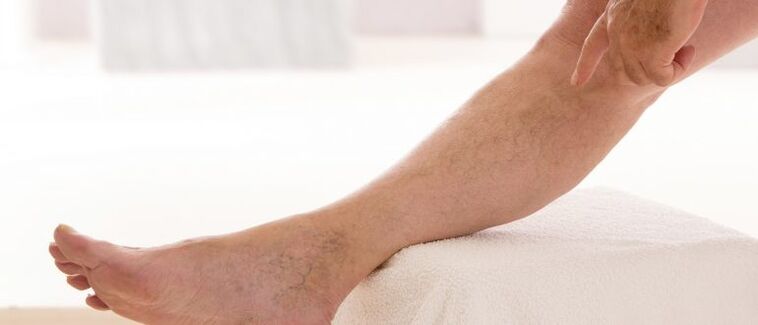
There is no need to recall the prevalence of vascular diseases.During the summer season, whenever you go out, you can notice blue stitches on the calves of women and men.Not everyone knows for sure how dangerous this pathology is.
What are the varicose veins
What are varicose veins?This is a disease in which the peripheral arteries swell.They become tortuous, knotted and protrude above the surface of the skin.
Normal blood circulation is disrupted and pressure appears.
When it reaches its maximum concentration, the walls of the blood vessels stretch.
The legs turn blue due to the large number of protruding vessels and venous network.
Risk factors
The factors that cause the appearance of varicose veins include:
- taking hormonal medication, pregnancy;
- the influence of extra pounds and obesity;
- hereditary factor;
- work at high temperatures, constantly sitting or standing.
You need to constantly monitor your lifestyle.Avoid overworking your legs or doing too much physical activity.
Carry out prevention as soon as the first signs appear.
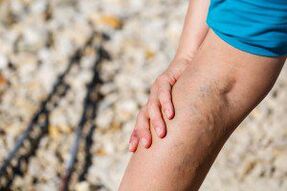
Causes
There are two conditional subgroups: primary and secondary causes of disease.
Primary:
- hard physical work;
- sedentary lifestyle;
- weight gain;
- hereditary factor;
- genetic predisposition.
Secondary:
- stress and anxiety;
- pressure in the area of arterial blood flow;
- physical training with heavy weights;
- clothes that are too tight, tight shoes;
- disturbance of the endocrine system.
Varice development mechanism
It all starts with light symptoms, it seems that simple fatigue affects the joints.At the end of the working day, swelling and pain appear in the calves, and cramps bother me periodically.
Soon, manifestations visible to the naked eye begin to develop.First, a slight vascular network appears on the legs, then nodularity.
The mechanism of development of the disease must be stopped at the first pain felt.
Steps
There are 6 stages of varicose veins.They develop quickly.If you do not treat the disease from the first stage, you can quickly end up on the operating table.
Degree – 0. A person begins to feel the full range of sensations inherent in the disease, but the examination does not give a positive result.
Degree - 1. Symptoms are progressing and a venous network appears on the legs.
Degree - 2. From this stage begins the manifestation of typical varicose veins.The joints are painful after an effort or long periods of stagnation.The arteries swell and nodes appear.
Degree – 3. For everything else, there is swelling, which is more pronounced in the evening.
Degree - 4. Trophic changes develop.The limbs have a sick appearance, the color of the skin changes and injuries appear.
Degree – 5. The totality of all manifestations and one ulcer healed.
Degree – 6. The trophic ulcer continues to actively develop.
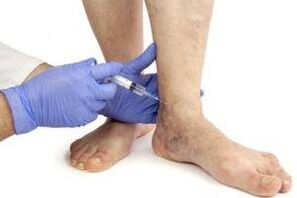
Types of vascular discomfort
This classification of varicose veins is divided based on the types of organs affected.
There are only 4 types, namely:
- reticular varicose veins.At this stage, there are no complications, only the small capillaries are affected.Therapy quickly eliminates this defect;
- segmental.It is considered the initial stage of varicose veins.The tributary arteries are affected;
- Major varicose veins are called when the large and small saphenous arteries are affected.The ducts widen because the symptom is insufficient circulation;
- Pickker.The bond veins and the superficial vessels under the skin expand.
The listed types of varicose veins are characteristic of different stages of development and manifestation of venous deformation.
To what extent is the disease dangerous in the absence of rapid treatment?
With this pathology, it is very important to quickly seek help from specialists.Each step quickly moves to a new one.
Having gained speed, varicose veins can enter more serious problems.
- Thrombosis.When blood thickens, it blocks the vessels.Rags form.Legs hurt and swell.
- Teleangiectasia.The harmony that does not aesthetically decorate the legs.Vascular networks appear.And also seizures and swelling are affected.
- Thrombophlebititis.A complex disease with characteristic symptoms.Dark skin, redness, blood vessels blocking, blood clots.
- Trophilical ulcer.This is the consequence of a serious form of varicose veins.Blood circulation is broken, open wounds, ulcers appear.
- Bleeding.The arteries are so covered and swollen the skin that it becomes thinner and breaks over time.The hemorrhage can be internal and external.
Diagnosis
Often the symptoms are shiny and clearly expressed.
Do not make a diagnosis yourself, it is preferable to undergo an examination by specialists.
Patient complaints
Initially, varicose veins do not show themselves.
The most common complaints may be swelling, fatigue after heels, and seizures at night.
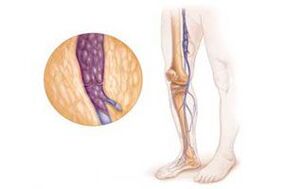
Clinical inspection
The appearance of the lower limbs will indicate a diagnosis.The legs are swollen, with a light or pronounced vascular mesh.
In the last stages, ulcers are possible.
Instrumental techniques
The doctor should be directed to ultrasound diagnostics.This method is very informative.It will show the condition of blood vessels, blood circulation, permeability, blood clots, etc.
Laboratory techniques
Using tests, you cannot find a pathology, but it will certainly help discover the condition of the blood.
An excessive quantity of leukocytes indicates that an inflammatory process occurs in the body.
What specialists need to contact
If disturbing signs and symptoms are detected, specialists will immediately carry out diagnostics.
Which doctor is needed?
First of all, a phebologist.The doctor's specialization is specifically aimed at the study of venous pathologies.
Therapist.The doctor will surely prescribe tests, according to the results, will direct a specific specialist, which will make you save time.
Vascular surgeon.Its task is simple, to determine whether the state of venous and blood vessels has changed in connection with the development of the disease.Accordingly, prescribe treatment or prevention.
Angiologist.Specialists in this field prefer conservative intervention.This only eliminates further growth of symptoms.Therefore, in heavy stages, visiting this doctor will be inappropriate.
Pathology symptoms
To avoid running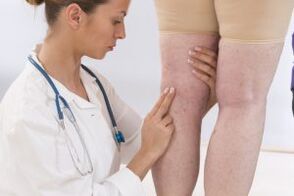 from the disease to incurable complications, it is necessary to know all the symptoms that may appear during the development of this disease.
from the disease to incurable complications, it is necessary to know all the symptoms that may appear during the development of this disease.
Main features:
- the appearance of heat;
- pain and heaviness;
- swelling and cramps in the evening;
- The venous network is clearer than usual;
- seals on the skin.
Secondary signs:
- external changes cover only the area of the fossa below the knee and the back surface of the leg;
- The affected tissues are palpated;
- swelling of soft tissues and feet;
- pigmentation and thickening of the skin;
- trophic ulcers.
There are also severe symptoms of varicose veins that require immediate hospitalization: bleeding, rupture of lymph nodes.
Therapy
The planned treatment of varicose veins depends on its development.
Conservative methods can be used by patients who immediately consult a doctor.
Drug treatment
After undergoing a medical diagnosis, the doctor prescribes a drug treatment necessary in case.
After treatment, the patient should be diagnosed again to ensure that it is not necessary to continue treatment.
In other cases, drugs are taken several times.
Use of compression materials
A phebologist individually selects special underwear, which restores without surgery.
Diet
The patient should use foods to strengthen the vascular walls that prevent blood clotting and the appearance of blood clots.They contain the main component - Kumarin.
For example: red currants, garlic, cherry, lemon.
Exercise therapy
The exercise with this disease is very important.
Useful loads activate blood circulation and its flow in the lower limbs.

Physiotherapy
One of the varicose vein treatment methods is physiotherapy.The procedures are selected and prescribed only by a doctor according to the individual evolution of the disease.
This can be a massage or laser method.
Hirudotherapy
This procedure relaxes the muscles, dilutes blood, normalizes blood pressure, restores the lymphatic flow.
Surgery
Surgical measurements are used when the patient turned late to get help.
Main operating methods: phleectomy, short stripping, endoscopic dissection of the veins.
Varice prevention
The preventive methods of the disease are very important, in particular at the initial stage of development.
Try to walk more, do not wear tight shoes and clothes.Do not get involved in campaigns in a bathhouse or sauna.
After a hard day, you can do simple exercises that promote relaxation.
Gymnastics
Light exercises, selected by a specialist, will activate blood circulation in the legs.
There are complexes that can be done not only at home, but also at work.
Traditional therapy
Sometimes traditional grandmother's treatment methods are no less effective.
Here are some of them:
- Horse chestnut dye.Three courses are required, each of them takes place like this: for 7 days before meals, drink a tablespoon of tincture.Then we take a break for 14 days and then continue.To prepare it, you need to take 50 grams of plant flowers, 0.5 liters of alcohol.Pour in the chestnuts and leave to rest for two weeks.
- To strengthen blood vessels, drink fresh fruit and vegetable juices every day.Regular saturation of the body with vitamins will prevent the development of the disease.
What is harmful with varicose veins
The disease described above does not like heat and huge electrical charges.You cannot jump, run or exercise on a treadmill or in the steppe.
Dumbbell lovers will also have to postpone the session in order to eliminate the load on the lower extremities.


















